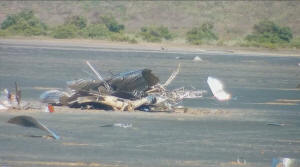SpaceX Starship SN11 rocket fails to land safely after test launch in
Texas: SpaceX
 Send a link to a friend
Send a link to a friend
 [April 01, 2021]
(Reuters) - An uncrewed SpaceX
Starship prototype rocket failed to land safely on Tuesday after a test
launch from Boca Chica, Texas, and engineers were investigating, SpaceX
said. [April 01, 2021]
(Reuters) - An uncrewed SpaceX
Starship prototype rocket failed to land safely on Tuesday after a test
launch from Boca Chica, Texas, and engineers were investigating, SpaceX
said.
"We do appear to have lost all the data from the vehicle," SpaceX
engineer John Insprucker said in a webcast video of the rocket's flight
test. "We're going to have to find out from the team what happened."
The webcast view was obscured by fog, making it difficult to see the
vehicle's landing. Debris from the spacecraft was found scattered five
miles (eight km) away from its landing site.
The Starship was one in a series of prototypes for the heavy-lift rocket
being developed by billionaire entrepreneur Elon Musk's private space
company to carry humans and 100 tons of cargo on future missions to the
moon and Mars.

The complete Starship rocket, which will stand 394 feet (120 metres)
tall with its super-heavy first-stage booster included, is SpaceX's
next-generation fully reusable launch vehicle - the center of Musk's
ambitions to make human space travel more affordable and routine.
[to top of second column]
|

The debris following an explosion of the SpaceX Starship SN11 after
a test launch is seen in Boca Chica, Texas, U.S., March 30, 2021 in
this still image obtained from a social media video. Video taken
March 30, 2021. LabPadre Media/via REUTERS

A first orbital Starship flight is planned for year's end. Musk, who
also heads the electric carmaker Tesla Inc, has said he intends to
fly Japanese billionaire Yusaku Maezawa around the moon in the
Starship in 2023.
Starships SN8 and SN9 previously exploded upon landing during their
test runs. SN10 achieved an upright landing earlier this month, but
then went up in flames about eight minutes after touchdown.
"Looks like engine 2 had issues on ascent & didnít reach operating
chamber pressure during landing burn, but, in theory, it wasnít
needed," Musk tweeted on Tuesday, after SN11's test flight.
"Something significant happened shortly after landing burn start.
Should know what it was once we can examine the bits later today."
(Reporting by Gabriella Borter; Editing by Chizu Nomiyama and
Jonathan Oatis)
[© 2021 Thomson Reuters. All rights
reserved.] Copyright 2021 Reuters. All rights reserved. This material may not be published,
broadcast, rewritten or redistributed.
Thompson Reuters is solely responsible for this content. |